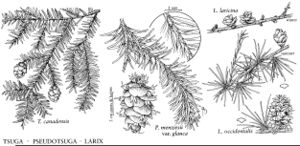Larix
Gard. Dict. Abr., ed. 4 vol. 2. 1754.
| Taxon | Illustrator ⠉ | |
|---|---|---|
 | Larix occidentalis Pseudotsuga menziesii var. glauca Larix laricina Tsuga canadensis | John Myers John Myers John Myers John Myers |
Trees deciduous; crown sparse, open. Bark silver-gray to gray-brown on young trees, becoming reddish-brown to brown, smooth initially, scaly to thickened and furrowed with age. Branches whorled; short (spur) shoots prominent on twigs 2 years or more old, each bearing leaves (needles), and often pollen cone, or seed-cone; lateral long-shoots (sylleptic branches) sometimes produced by current-year growth increments; leaf-scars many. Buds rounded. Leaves in tufts of 10–60 on short (spur) shoots or borne singly on 1st-year long-shoots, deciduous, ± flattened, with abaxial keel, sessile, base decurrent, sheath absent, apex pointed or rounded; resin canals 2. Pollen cones solitary, ovoid-cylindric, yellowish. Seed-cones maturing in 1 season, persisting several years, erect, globose to ovoid, usually terminal on short-shoots and thus appearing stalked, sometimes sessile on 1-year-old long-shoots; scales persistent, circular to oblong-obovate, thin, lacking apophysis and umbo; bracts included or exserted. Seeds winged; cotyledons 4–6. x =12.
Distribution
Boreal and cold north temperate areas, North America, Eurasia
Discussion
Species of Larix are present in most boreal regions; they often form only a minor component of the vegetation. Some are important for their hard, heavy, and decay-resistant wood. Only a few have received any horticultural attention; some cultivars exist for the most commonly cultivated Old World larches, L. decidua Miller and L. kaempferi (Lambert) Carrière, but almost none for the North American species.
Species 10 (3 in the flora).
Selected References
Lower Taxa
Key
| 1 | Twigs glabrous; seed cones 1-2 cm, scales 10-30, surpassing bracts at maturity; short-shoot leaves 1-2 cm, thickness 0.3-0.5 mm; pollen 53-65 um diam. | Larix laricina |
| 1 | Twigs initially pubescent, becoming glabrous, or strongly tomentose for 2-3 years; seed cones 2-5 cm, scales 45-55, shorter than awn-tipped bracts at maturity; short-shoot leaves 2-5 cm, thickness 0.4-0.6 mm; pollen 71-93 um diam. | > 2 |
| 2 | Twigs initially pubescent (but not tomentose), becoming glabrous or very sparsely pubescent during first year; seed cones 2-3 cm, scale margins entire, cone stalk 3.5-5 mm diam.; width-to-thickness ratio of short-shoot leaves 1.3-1.7, adaxial surface with shallow convex midrib; resin canals 20-50 um from margins, each surrounded by 5-7 epithelial cells. | Larix occidentalis |
| 2 | Twigs strongly tomentose; seed cones 2.5-4(-5) cm, scale margins erose, cone stalk 2.5-4 mm diam.; width-to-thickness ratio of short-shoot leaves 1.2-1.4, adaxial surface 2-angled; resin canals 40-80 um from margins, each surrounded by 6-10 epithelial cells. | Larix lyallii |
"thin" is not a number.